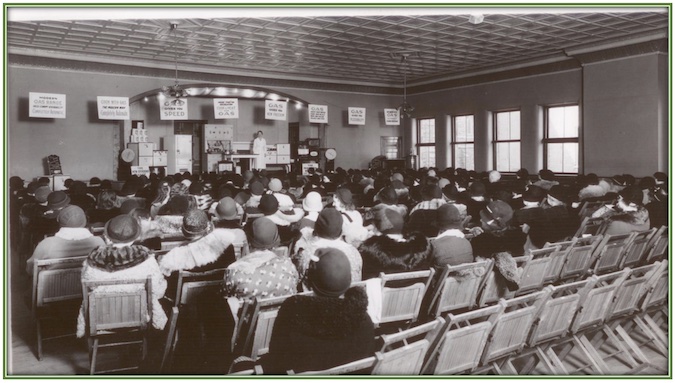‘Cooking School’ in Albion in 1932 introduced new gas appliances
By Catherine Cooper, Orleans County Historian
“Illuminating Orleans” – Vol. 3, No. 23
ALBION – The photo above shows ladies assembled at a Cooking School presentation held at the Lyceum of St. Joseph’s Church, Albion. The photograph is dated 1932. Since the ladies were wearing coats and hats, we can assume that it was held during the winter.
“COOK WITH GAS – The Modern Way – Completely Natural”
“GAS gives you SPEED”
“GAS gives you NEW FREEDOM”
“GAS gives you FLEXIBILITY”
As we can tell from these signs displayed across the top of the stage, this presentation promoted the use of gas appliances.
Cooking methods and techniques had changed rapidly during the first decades of the 1900s. Several generations of cooks had been accustomed to cooking on wood stoves. They tasted, tested, and adjusted ingredient amounts as necessary and adapted to cooking with inexact and fluctuating temperatures.
Gas stoves began to replace wood stoves in the 1920s and were popular until the 1940s. Cooks appreciated not having to tend to a fire, deal with ashes, warm up the kitchen on hot summer days or wait a long time for the oven to attain a cooking temperature.
While electric appliances, such as toasters, irons, and coffee percolators became popular in the 1920s, electric stoves experienced a slower roll-out. Early models were not reliable and did not heat as quickly as gas stoves.
“Cooking Schools” were popular from the 1930s to the 1950s. Appliance manufacturers and local dealers hosted them to demonstrate the ease of use of their products. Housewives attended, eager to learn new cooking techniques and recipes as well as enjoy a social outing. The promise of prizes and free promotional items added to the attraction of the occasion.
In 1930, the Medina Daily Journal hosted a week-long Cooking School at the Park Theater “for the pleasure and inspiration of the housewives of the vicinity and for the real and lasting benefit of the community.”
Mrs. Lautz, a noted home economist and educator, was engaged to present lectures on the new labor-saving equipment and utensils available, as well as on budgeting and menu-planning. New and interesting recipes were demonstrated each day, the keynote of the program being the desire to relieve the monotony experienced by housewives charged with the duty of preparing three meals a day, every day of the year.
Anticipating the resistance of some ladies to the notion of needing a “cooking school,” Mrs. Lautz noted that the hints and techniques shared at the cooking sessions would be beneficial to all, regardless of how proficient they were.
“Cooking school classes are not to be looked on as gatherings of novices, but as conferences of progressive women to exchange ideas, exactly as experienced businessmen get together to exchange business ideas.”
It is interesting to note the changing perceptions of the housewife during this time. The role had changed from that of being a self-contained provider – who prepared meals from home grown products to being a consumer, who required new equipment for standard tasks, and different ingredients for new recipes.
The new housewife was also an adapter, an economist and efficiency expert, more independent and assertive. The market potential represented by this emerging demographic was not lost on big business, who soon focused their advertising campaigns on this new customer.


























































